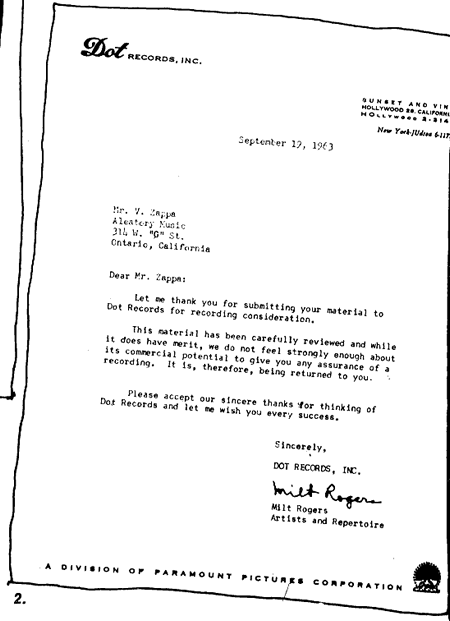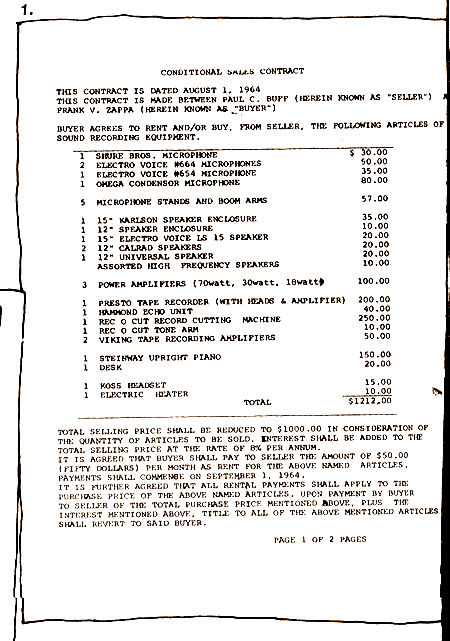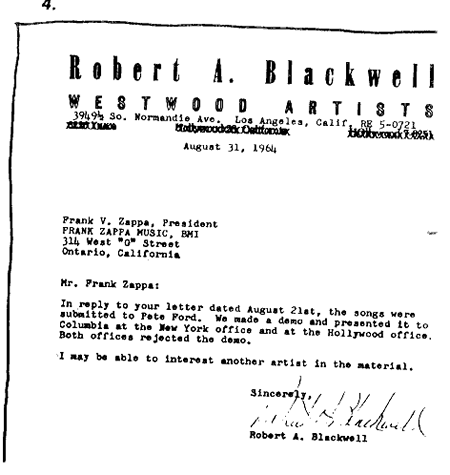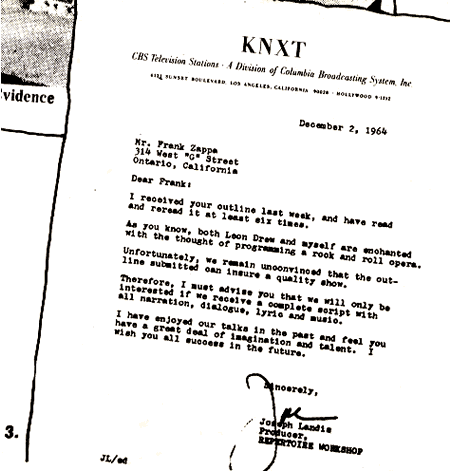FZ 1963-65
"The Soots"
Sometime around the summer of 1963 and probably then again in 1964, old friend Don Van Vliet came to the studio and recorded some songs. This is FZ in a 1970 interview by Mark Williams (Sounds, November 1, 1970):
The earliest things he recorded were "Slippin' And Slidin'," completely in Jimi Hendrix style with a slow rhythm, the Howlin' Wolf piece "Evil," "The Grund," "Tiger Roach," and "Vicious Intentions," a slow blues.
Tiger Roach appeared finally in The Lost Episodes (1996), and in the liner notes FZ is quoted saying:
The band was in the studio mixed down to one track, and Don was in the hallway with just the leakage coming through the door, perusing an X-Man comic book pinned on the wall, riffling through it as we did it. There are three or four more Beefheart masters from this period, including a Howlin' Wolf-like version of "Slippin' and Slidin'" an instrumental called "I'm Your Nasty Shadow," and "Metal Man Has Won His Wings."
Metal Man Has Won His Wings was released in the first Mystery Disc (1985), and FZ said in the liner notes:
In our spare time we made what we thought were 'rock & roll records.' In this example, Vliet was 'singing' in the hallway outside the studio (our vocal booth) while the band played in the other room. The lyrics were derived from a comic book pinned to a bulletin board near the door.
FZ talks about those sessions also in his book (p. 49-50):
After I moved into 'Studio Z,' Don Van Vliet came to visit. I made some recordings with him then which predated the Beefheart Magic Band. The group was called the Soots. Some of the songs were "Metal Man Has Won His Wings," "Cheryl's Canon" and a cover version of the Little Richard song "Slippin' and Slidin'" (as if sung by the Howlin' Wolf). (...) Through Paul Buff I had met people in Hollywood who worked in those departments, so I went to a guy at Dot Records named Milt Rogers with two of the Soots masters. He listened for a while and said, "We can't release these—the guitar is distorted."
And this is the actual Dot rejection (reproduced in the Ten Years booklet):

2. Material rejected by this notice include Any Way The Wind Blows, Take Your Clothes Off When You Dance (original instrumental version), master recordings of Don Vliet (Captain Beefheart) singing Slippin' & Slidin'. Last item was rejected by Mr. Rogers when questioned by phone after receipt of this notice on the grounds that "the guitar was distorted."
Biffy the Elephant Shrew showed us in his electrifying announcement, Metal Man Has Won His Wings: The Source, that "Metal Man Has Won His Wings" must have been some time after February, 1964, and, as Heitor Mendes noted in alt.fan.frank-zappa, "Tiger Roach" couldn't have been recorded before November, 1964, as it quotes a comic-book released around that month. On the other hand, "Slippin' And Slidin'" must have been recorded before September, 1963.
Now we can't say when the rest of the songs mentioned ("Evil," "The Grund," "Vicious Intentions," "I'm Your Nasty Shadow" and "Cheryl's Canon") were recorded, as they're cited in different times and groups that always include "Slippin' And Slidin'" (from 1963) and one of the two known 1964 recordings. A graphic would help:
| 1970 Interview |
TRFZB 1989 |
TLE 1996 |
| Slippin' And Slidin' |
Slippin' And Slidin' |
Slippin' And Slidin' |
| Evil |
|
|
| The Grund |
|
|
| Vicious Intentions |
|
|
| |
|
I'm Your Nasty Shadow |
| |
Cheryl's Canon |
|
| |
Metal Man Has Won His Wings |
Metal Man Has Won His Wings |
| Tiger Roach |
|
|
Run Home, Slow
The last Pal Recording Studio production in which FZ & Paul Buff collaborated was the single with "Hurricane" and "Sweet Love" (Daytone 6401) by Conrad & The Hurricane Strings, released in December, 1963.
Paul Buff got married and left his Pal Recording Studio to work at Art Laboe's Original Sound Studio, where he built a 10-track machine. There he was the sound engineer of another FZ project, the recording of the soundtrack for Run Home, Slow (the movie written by FZ's former English teacher in Lancaster, Don Cerveris). This is Paul Buff on his correspondance with Splat:
To my recollection, the Run Home Slow soundtrack did not use the Pomona Valley Symphony—they were Hollywood studio musicians, I believe. I did the recording at Original Sound, with Zappa producing and directing.
Chuck Foster was one of those Hollywood studio musicians, and he mentioned some others in his interview with Geoff Wills (available at the United-Mutations site):
Chuck played trumpet on the soundtrack music for the film Run Home, Slow, and he remembered a number of other musicians who were also involved. These were Ron Myers (trombone), Chick Carter (flute, tenor sax, baritone sax), Don Christlieb (bassoon), Pete Christlieb (tenor sax), Chuck Domanico (bass) and John Guerin (drums).
And this is FZ in his book (p. 43):
After endless delays, Run Home Slow (starring Mercedes McCambridge) was completed and scored in 1963. I even got paid for it—not all of it, but most of it. I took part of the money and bought a new guitar, and used the rest to 'buy' Pal Records from Paul. In other words, I agreed to take over his lease and the rest of his debt.
Meanwhile, my marriage fell apart. I filed for divorce, moved out of the house on G Street, and into 'Studio Z,' beginning a life of obsessive overdubbage—nonstop, twelve hours a day.
Studio Z
It's hard to say when FZ actually moved to Studio Z, because anyway he kept using the G Street address legally until December 1964 at least (see the KNXT rejection). The formal buying of Pal Recording Studio anyway took place on August 1, 1964. The contract appeared reproduced in the "Ten Years" 1974 booklet:

1. Bill of Sale for Cucamonga recording studio.
This is Paul Buff's comment about the sale:
When Allison and I got married and I got the gig with Art Laboe at Original Sound, I let Zappa use the studio for several months, then sold it to him for a little bit of money, his old drums set, his vibes and his Jazzmaster guitar (Which was later stolen from me at Original Sound).
The first Mystery Disc includes a track called Opening Night At Studio Z (Collage) and FZ described it in the liner notes:
This is a collage of some dialog and music from the party on opening night. The guests included Captain Beefheart, his former girlfriend Laurie, Ray Collins, Motorhead Sherwood, and Bob Narciso. Bob is singing about the Pall Malls. Motorhead is talking about his girlfriend.
Motorhead had come to live with FZ in the studio, as FZ says in his book (p. 43):
He came to Cucamonga and didn't have a place to stay, so I invited him to move into the studio with me.
Motorhead had been living with Kenny Williams, and Dwight Bement recalls in his conversation with Patrick Neve that he also lived with Ronnie Williams:
Jim Sherwood and Ronnie lived together for a while in a boarding house on 4th street in National City. Sometime around 1963-64-65?
Frank Zappa Music
FZ created a new publishing company, Frank Zappa Music, BMI, and tried once again to sell Any Way The Wind Blows and Take Your Clothes Off When You Dance. This is the rejection notice from Columbia, August 31, 1964 (from the Ten Years booklet):

4. Rejection notice for Any Way The Wind Blows and Take Your Clothes Off When You Dance.
In an interview with FZ by Barry Miles, from September 13, 1970 (here's an extract) there was this conversation:
FZ: One time we delivered to Bob Keane masters for . . . ah, you know the album Lumpy Gravy?
Miles: Yeah.
FZ: You know, the last tune on Lumpy Gravy, it goes ta-ta-dan ta-ta-ta ta-ta-dan . . . then goes a bongo fill, ta-da-ta ta-da-ta da-de-dee de-dee . . . it's called "Take Your Clothes Off When You Dance," it was a tune that went on the We're Only In It For The Money album. Well, we took that very same master that's on Lumpy Gravy . . .
Miles: Mm-mmh . . .
FZ: Because it was recorded in '62 or '63, yeah, and took it to him. And uh, he sat on it and never release it, and we got it back.
So, if the "very same master that's on Lumpy Gravy" is the same he was trying to sell around '62 or '63 (actually '63 or '64), those rejection notices from Dot Records and Blackwell probably referred to the surf version of Take Your Clothes Off When You Dance that appears on Lumpy Gravy, better than to the jazz version which appeared on The Lost Episodes.
Captain Beefheart vs. The Grunt People
FZ in his book (p. 54):
Shortly after moving into 'Studio Z,' I heard about an auction at the F. K. Rockett Studio in Hollywood. They were going out of business and dumping some scenery. For fifty dollars I bought more scenery than I could fit in the studio, including a two-sided cyclorama—purple on one side for night, blue on the other side for day—a kitchen, a library interior, a building exterior—everything I needed to make a cheap movie. Every piece that would fit through the doors was dragged in, set up and repainted.
I ended up sleeping in the set for Billy Sweeney's Laboratory. In the back of the studio, next to the toilet, I built a totally implausible, two-dimensional, cardboard rocket ship.
I painted all the sets myself and wrote a script based on the people and facilities available at the time: Captain Beefheart vs. the Grunt People.
Paul Buff in the Cucamonga liner notes:
He had turned the whole studio into his vision of the B-movie spaceship. I remember him vividly getting excited about it—asking for any junk electronics I had, and taking meters and painting them day-glo orange and putting knobs all over a board and painting it with different day-glo colors. The last time I was in Studio Z, to go to the bathroom you had to go out of the cockpit of this ship and crawl down tunnels underneath and come out in the bathroom.
On September 20, 1964 (my first birthday), there was an article in the Ontario Daily Report regarding FZ and his "Beefheart" movie project. The article, which included pictures of the sets, is reproduced on page 37 of "The Son Of Revised" edition of Greg Russo's book:
He has written a movie which he is planning to produce from the Cucamonga studio. It is titled "Captain Beefheart." (...) [The script] includes the minute details of the planned film as well as the cast of characters and their dialogues.
By the way, according to that September, 1964, article, FZ apparently hadn't still moved into the studio, even if the scenery was already set up.
A budding playwright and songwriter, young Zappa lives at 314 W. G St., Ontario.
Maybe it was just his official address.
According to an interview from Society Pages #1 (1988), the main theme music for Captain Beefheart vs. The Grunt People was the piece that later would be known as Lumpy Gravy Theme or Duodenum (or even Bwana Dik).
FZ would later work on the script again in 1969, and here are some scans of the actual script in that stage: http://www.beefheart.com/zigzag/gruntpeople/
I Was A Teen-age Malt Shop
While FZ was trying to raise money to make the Beefheart movie, he had another idea for a rock & roll teen-age opera, which he offered to Columbia. The name of the project was I Was A Teen-age Malt Shop. Of course it was rejected. This is the note from December 2, 1964, reproduced in the Ten Years booklet:

3. Rejection notice for I Was A Teenage Malt Shop.
FZ talked about the plot in a 1974 interview with Patrick and Barbara Salvo (Melody Maker, January 1974):
It was the idea of an old man who has a daughter named Nelda who was a cheerleader. The old man has a recording studio that hasn't hit and there's an evil landlord who's going to foreclose on him. So there's this group that comes in with a teenage hero that goes to the high school called Med the Mungler, a teenage Lone Ranger, and it was just a fantasy-type thing with rock and roll music on it.
The name of the hero was actually "Ned The Mumbler" and FZ recorded some tracks for the opera in the studio. Don Van Vliet appeared on his role of Captain Beefheart doing the narration, FZ was Ned, and Allison Buff was Nelda. This is Paul Buff on his correspondence with Patrick Neve:
Allison Buff was my first wife (1964). She, in fact, was a waitress at the Cucamonga Maltshop and recorded a lot of things at Pal, both with me and with Frank. Allison had a great memory for music and harmony and a pretty good voice. Frank had her written into his Teenage Opera—which never was realized.
Part of the original recording appeared in the first Mystery Disc (1985) as the instrumental opening theme I Was A Teen-age Malt Shop and Don Van Vliet's introduction confusingly labeled as The Birth Of Captain Beefheart. The opera also featured an early version of Status Back Baby, sung by Allison Buff, the unreleased Ned The Mumbler, and probably the instrumental Toads Of The Short Forest.
The Power Trio (The Muthers)
FZ talks about one oh his early groups on a Guitar Player interview from 1977:
I had a three-piece power trio called the Mothers [Muthers], with Les Papp on drums and Paul Woods on bass, and we were working at a place called The Saints & Sinners in Ontario, California. It was, like, mostly Mexican laborers, a go-go bar, lots of beer, and a few waitresses who would jump on the tables—that type of thing.
I used to have to sing with that trio at the Mexican place. But that was mostly blues-type songs.
Then on the first Mystery Disc there's a track called Power Trio From The Saints 'N Sinners, and FZ says in the liner notes:
Another weekend gig recording from an orange-pickers' bar in Montclair. Later that night, a deranged Mexican tried to pull my mustache off. F.Z., guitar, Les Papp, drums, Paul Woods, bass.
On the Melody Maker interview from 1974, FZ answered this:
Q: Didn't Studio Z help create the forerunner of the Mothers Of Invention, the Muthers?
FZ: Yeah, it was a three-piece group with Paul Woods on bass, Les Papp on drums and me on guitar, and we worked at a club called the Saints and Sinners in Ontario, California and it was about as close as you could get to an Eric Clapton-Cream type format at that time. We weren't full of amplification and power but we were the same type of format, a guitar trio and I was doing the vocals, a rhythm and blues type thing. Then came Muthers which was just for short motherfucker.
Q: You were arrested for dabbling in pornographic film making.
FZ: Oh yeah, it was around that time.
Then there's another piece with Les Papp on drums in the Mystery Disc called Bossa Nova Pervertamento, and FZ says in the liner notes:
A "STUDIO Z" late-night jam with F.Z. on acoustic guitar, Les Papp on drums, and Bobby Saldana on bass.
When this tune was recorded was revealed by FZ during the KWST radio show with Captain Beefheart, November 1, 1975:
The thing that's in the background right now is the tape that we made the night before the cops came in and raided the studio in Cucamonga.
Of course, the thing in the background was Bossa Nova Pervertamento, so if the bust happened on March 26, 1965, then the piece was recorded in March 25. But even if Les Papp worked with him in the studio, it seems that by that time FZ had another band with a pair of old friends in Sun Village.
Village Inn Band
While talking about the times when Motorhead came to live at Studio Z, FZ says in his book (p. 43):
By then I had landed a weekend gig at a place called the Village Inn, in Sun Village, eighty miles away [from Cucamonga].
This is the band that appears in the first Mystery Disc, on the cuts The Village Inn and Steal Away (a cover version of the song by Jimmy Hughes which was released in 1964 and which entered the hit lists around June, 1964). The band was:
- FZ—guitar
- Johnny Franklin—bass
- Toby—drums
- Motorhead—sax
- Cora—guest vocalist
On an interview with Kurt Loder for Rolling Stone from 1988, FZ says he was doing the Village Inn gig at the times of the infamous bust:
So here I am living in this studio, and living there with me were two white girls and a black baby. (...) And in order for me to earn a living—since there weren't surf bands beating down my door to record yet another "Wipeout" there I worked on weekends playing guitar at this barbecue joint in Sun Village, up near Lancaster, seventy-five miles away. I got seven dollars a weekend only job I could get. Anyway, while I'm up there doing my gig, apparently, these two girls had gone out in front of the studio and were playing on the street with the black baby—which offended all parties concerned in this little village. So, the next thing I know, I got this guy knocking on my door saying he was a used-car salesman—saw the sign, they're having this party and can I make an entertaining movie for him? (...) To me, it was a fuckin' joke, okay? I mean, the minute the man started talking about "oral copulation," I should've gone, "Huh?" But, no, I didn't. Because remember, I was making seven dollars a weekend up there in Sun Village.
More about that band on the interview Don Menn did for Zappa! special from Guitar Player in 1992:
My only source of income was working this barbecue joint up in Sun Village. I'd work there on weekends. (...) It was just a pickup band. Some guys that I knew from high school who lived up there. I would come up, plug in my guitar, play with them.
The Switchmaster & The Space Boy
Let's stop for a moment in that new guitar that FZ supposedly bought around the same time as Studio Z (August, 1964). On the Guitar Player interview from 1977, FZ specified which guitar it was:
With the money I got from the film job I bought a Gibson ES-5 Switchmaster, which I used for about five years. I recorded the first three albums with that guitar.
The Gibson ES-5 was an expensive guitar. How much? Here's guitarist Del Kacher (aka Del Casher) on a Vintage Guitar Magazine interview from 1997:
To me, Frank was one of the most exciting musicians I've known, because he went beyond being a musician. When I first met him, he said he was interested in playing guitar, and asked me what was the most expensive guitar, and I told him that the most expensive one was a Gibson ES-5, like the one I had, so he went out and bought one.
Now, when did FZ and Kacher met? They're known to have work together in the song Space Boy (apparently for the short film Space Boy, released in 1973). Here's Kacher on that same interview:
Frank Zappa was from Cucumonga; he came by one day, said he'd heard about me, and said he wanted to record something for a singer who had a song about a Russian cosmonaut who was lost in space (chuckles). I used to get these strange requests all the time, and Frank's request was no different. In those days he wasn't a guitar player, so he asked me to play guitar and bass, laying down tracks using the Ecco-Fonic to get the spacey sounds, while he played on a snare drum I had in the studio. I think this was one of the first recordings Frank did when he arrived in L.A. He was very pleasant, and he looked as weird as the sounds we created, but boy, was he talented! When he played the drum, I knew something great was going on, and we enjoyed that session so much he asked me to join his new group. I politely declined because my studio schedule was beginning to happen.
On another interview for Vintage Guitar in August, 1998, Kacher is more specific about the date:
Frank Zappa came to me in around '65—I didn't know who he was, he had a beard and everything—and he wanted some real wild sounds. And we did this little production together and I just dug the tape out about a week ago and I said, "Geez, I can't believe I did all this with the Ecco-Fonic!"
FZ moved to Los Angeles around the spring of 1965. I think if he still had the Cucamonga studio working at the time of the recording of "Space Boy" he wouldn't have gone to another studio to record this project (unless he would have wanted to specifically work with Kacher), and that the mentioned FZ's "new group" probably is The Mothers, of which we'll talk in the next chapter.
Original article & compilation by Román García Albertos © 2003
http://globalia.net/donlope/fz/
This page updated: 2017-02-03



